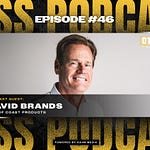The Rise of D2C with Ted Wentz III
On this episode of the “Only the Strong Survive” podcast, host Dan Kahn explores alternatives to traditional retail and wholesale models and the future of direct-to-consumer sales with Quadratec CEO Ted Wentz III. Founded in 1990 by Ted’s father, Quadratec is one of the largest Jeep parts and accessories retailers in the world. Originally started as a direct mail company relying on paper catalogs, Quadratec
shifted focus as online commerce gained momentum. Today, Quadratec is a massive e-commerce success story that has navigated multiple market shifts and achieved its dominance without retail stores.
Helping guide Quadratec through the constantly shifting sands of e-commerce is Ted
Wentz III. Not wanting to join the family business initially, Wentz joined the Department of Homeland Security in the agency’s infancy after graduating from college. Eventually, he started his own e-commerce business, running it for eight years before joining Quadratec as its CEO five years ago. Through his interesting career path and time at Quadratec, Wentz has gained valuable insight into direct-to-consumer sales and how to keep ahead of the multiple challenges and changes e-commerce faces. Click on the link below to listen to his insights and keep reading for our top five takeaways, which include:
The continued evolution of e-commerce.
Why adapting to all of those changes is critical.
How customer preferences are changing.
Why hiring employees who are enthusiasts and subject matter experts is vital.
The best advice for handling the ups and downs of e-commerce.
E-commerce Is Still Rapidly Changing
The advent of Amazon and eBay helped fundamentally shift e-commerce into the mainstream. Platforms like Shopify and others have made setting up an e-commerce business relatively simple. Now, almost any brand of any size can quickly launch a website and start selling its products online. All of that happened in a relatively short time frame in the retail world. One of the latest shifts is larger companies abandoning the traditional wholesale model and selling directly to the consumer. But with a multitude of channels, e-commerce platforms, and even retail stores still an option, jumping into e-commerce isn’t as simple as it seems. “It is so much more complicated today than it used to be," says Wentz. "And I think I see more businesses get into trouble trying to navigate all of that than producing new products or trying to understand the consumer. It’s very easy to get trapped in the forest.”
Adapting is Key
With e-commerce in constant flux, the ability to adapt to those changes is vital. Sticking to a rigid business plan and not being flexible is a surefire way to sink your e-commerce business or get surpassed by your competitors. The good news is that there is opportunity in the chaos as your competition is in the same situation. There is the ability to surpass them instead, but you have to be willing to make changes and take calculated risks. “I think some of it is trial and error,” says Wentz about being successful in e-commerce. “That’s not the answer anyone wants to hear, right? It would be much more satisfying if there were a series of steps you went through and used a matrix, and you’d make the right decisions. There is some truth to that, but some of it is trial and error. It is 'let’s see if this works, and we can test it in a way that if it goes sideways, it isn’t going to really hurt us, right?'”
Customers Want to Connect with Brands
E-commerce can be split roughly into two groups of consumers. One is shopping for lower-cost commodities like household goods and is primarily concerned about price. The other is making bigger, more involved purchasing decisions on higher-cost items that require careful consideration. Competing on price against giants like Walmart and Amazon on everyday items people can get anywhere is almost impossible for smaller e-commerce platforms. But that latter group represents a significant opportunity as they want to connect with brands, learn from them, and believe in their products. “There’s still a level of engagement, knowledge, and understanding of the consumers' wants that you can win,” says Wentz. “There are all sorts of ways of tackling that, whether it is art, copy, everything you are talking about, or how you manage the monster that is listed on Amazon. There are a lot of different ways to attack it, whether it’s Amazon, Walmart, eBay, or whatever. I think the companies that can figure out how to do all of that are going to be the most successful.”
Hire Your Target Demo
Knowing as much as you can about your customers is critical in the e-commerce space. Gathering customer data and doing lots of market research is normal for many e-commerce companies. Surprisingly, Wentz admits to only doing some market research and not at the maniacal levels that some companies do. Why? Because he hires Jeep enthusiasts, who are Quadratec’s target demographic. They understand Quadratec’s customers because they are its customers, too. “When I walk into the call center, and I ask one of my folks, my marketing or content teams, or even the warehouse, ‘We’re thinking about doing this with our catalog or selling this product or coming out with the private label product. What do you think?’ They’re going to have an opinion,” says Wentz. “And they’re going to produce it with conviction and confidence. So right away, we have a great set of data when we make that decision.”
How to Survive and Thrive in E-Commerce
Launching an e-commerce business is easier than ever. However, creating a thriving brand that lasts more than a couple of years is not simple. Constant market changes, shifts in technology, varying customer preferences, inventory issues, the lingering effects of the pandemic and a shaky economy have all made running an e- commerce business extremely difficult. It definitely isn’t as easy as portrayed in some of the stories in the media about people making significant sums with their “side hustle” e-commerce site. Having led Quadratec through multiple challenges, Wentz has some stellar advice for anyone in e-commerce on handling adversity. “I think it is just like anything in life. You control the things that you can control,” says Wentz. “So the things that you can change, you make those changes. You try to leave a little bit of cushion in the system for the lows, take advantage of the highs when they’re there, and grab as much of that business as possible. And don’t spend too much time obsessing over the things you can’t control because you could easily wallow in that all you want. But go back to the drawing board, do what you do well and really do that well. Make sure you know who you are, and your customers know who you are, too.”












